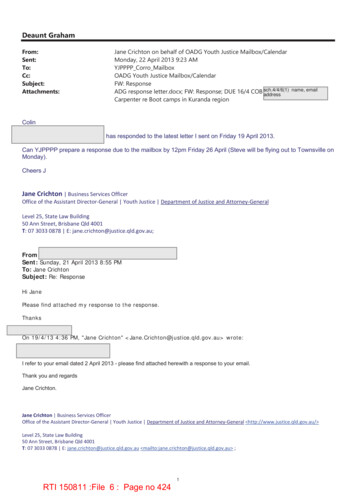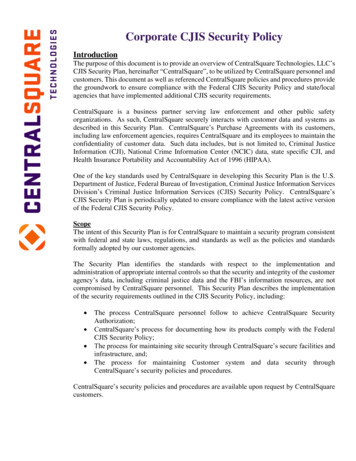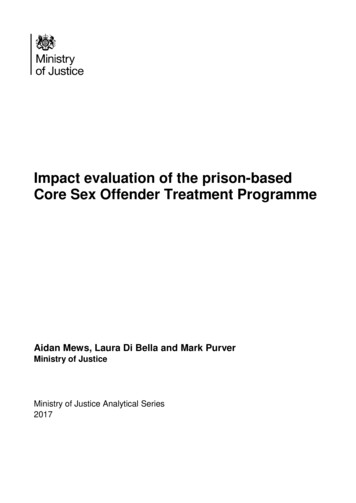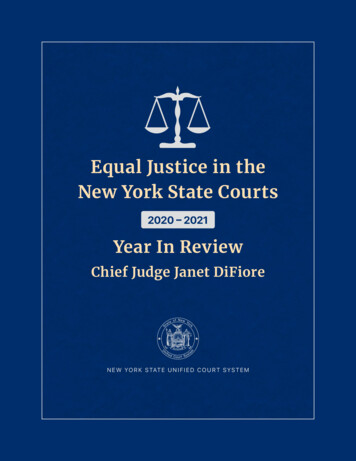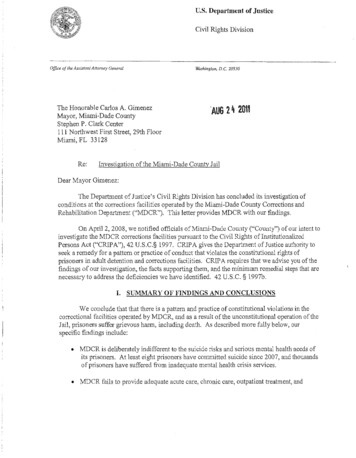
Transcription
u.s. Department of JusticeCivil Rights DivisionOffice of the Assistant Attorney GeneralThe Honorable Carlos A. GimenezMayor, Miami-Dade CountyStephen P. Clark Center111 Northwest First Street, 29th FloorMiami, FL 33128Re:Washington, D.C. 20530'AUG 24 2011lnvestigation of the Miami-Dade County JailDear Mayor Gimenez:The Department of Justice's Civil Rights Division has concluded its investigation ofconditions at the corrections facilities operated by the Miami-Dade County Corrections andRehabilitation Department ("MDCR"). This letter provides MDCR with our findings.On April 2, 2008, we notified officials of Miami-Dade Calmty ("County") of our intent toinvestigate the MDCR corrections facilities pursuant to the Civil Rights oflnstitutionalizedPersons Act ("CRIPA"), 42 U.S.C.§ 1997. CRIP A gives the Department of Justice authority toseek a remedy for a pattern or practice of conduct that violates the constihltional rights ofprisoners in adult detention and corrections facilities. CRIP A requires that we advise you of thefindings of our investigation, the facts supporting them, and the minimum remedial steps that arenecessary to address the de- iciencies we have identified. 42 U.S.C. § 1997b.I. SUMMARY OF FINDINGS AND CONCLUSIONSWe conclude that that there is a pattern and practice of constitutional violations in thecorrectional facilities operated by MDCR, and as a result of the unconstitutional operation of theJail, prisoners suffer grievous harm, including death. As described more fully below, ourspecific findings include: MDCR is deliberately indifferent to the suicide risks and serious mental health needs ofits prisoners. At least eight prisoners have committed suicide since 2007, and thousandsof prisoners have suffered from inadequate mental health crisis services. MDCR fails to provide adequate acute care, chronic care, outpatient treatment, and
-2 discharge services to prisoners with mental illness. Instead, MDCR inappropriatelyrelies on medication management that fails to consistently incorporate diagnoses ortreatment plans, even for prisoners with the most serious mental illnesses. MDCR is deliberately indifferent to the serious medical needs of prisoners includingaccess to care for acute medical needs, management of chronic health problems, andrecord keeping and quality assurance. Prisoners wait weeks and even months to receiveconsultations for care from HIV, cardiology, and neurology specialists. MDCR fails to provide adequate intake screening, initial health assessments and acutecare for newly incarcerated prisoners. Since 2008, at least five prisoners have died fromMDCR's failure to identify and treat prisoners withdrawing from drugs or alcohol. MDCR is engaged in a pattern or practice of using excessive force against prisoners.MDCR corrections officers openly engage in abusive and retaliatory conduct, whichfrequently causes injuries to prisoners. MDCR is deliberately indifferent to the serious risk of harm to prisoners posed by fellowprisoners. Corrections officers fail to supervise prisoners, particularly prisoners knownto be violent, resulting in ongoing harm and serious risk of harm. There is significantevidence to be concerned that the Jail fails to take reasonable steps to protect prisonersfrom sexual assault. The conditions of confinement within the Jail expose prisoners to an umeasonable risk ofhann from inadequate fire and life safety systems and environmental health andsanitation deficiencies, including umeasonable risk of infection from overcrowding andinadequate laundry, housekeeping, and pest controLII. INVESTIGATIONOn June 9-13, 2008, June 16-20,2008, and April 7-8,2009, we inspected the facilitytogether with consultants in the fields of corrections, custodial medical and mental health care,suicide prevention, and environmental health and sanitation. We interviewed administrative andcorrections staff, medical and mental health care providers, prisoners, and members of theMiami-Dade community. Our investigation also included the review of policies and procedures,incident reports, grievances, medical records, and use of force records and investigations,including documents provided by the County subsequent to our on-site visits. In keeping withour pledge of transparency and providing technical assistance where appropriate, our consultantsconveyed their preliminary impressions and concerns to County officials and the MDCRcommand staff at the conclusion of our tours.We are grateful to MDCR Director Timothy P. Ryan and his entire stafffor the assistanceand cooperation extended to us. We found the MDCR officials helpful and professionalthroughout the course of the investigation. MDCR provided us with access to records andpersonnel, and responded to our requests, before, during, and after our on-site visits, in atransparent and forthcoming manner. We also appreciate MDCR's receptiveness to ourconsultants' on-site recommendations.
- j III. BACKGROUNDThe corrections facilities operated by MDCR (collectively "Miami-Dade County Jail" or"the Jail") hold an average of7,000 prisoners in a complex of buildings spread out across thecounty, making it the nation's eighth largest jail. The Jail has six corrections facilities: the Pre Trial Detention Center ("PTDC"); the Women's Detention Center ("WDC"); the Training andTreatment Center ("Stockade"); the Turner Guilford Knight Correctional Center ("TGK"); andthe Metro West Detention Center ("MWDC"). Additionally, MDCR operates a boot campprogram, with a housing facility adjacent to TGK ("Boot Camp").The prisoners incarcerated in the Jail are awaiting trial or serving sentences of less thanone year. Two of the five facilities, PTDC and TGK, are booking facilities. These two facilitiesprocess and house all classifications of prisoners. PTDC, the County's main jail building locatedacross the street from the County Courthouse, has approximately 1,700 beds for male prisoners,and TGK has 1,300 beds for male, female, and juvenile prisoners. WDC has 375 beds and onlyhouses female prisoners. The Stockade, the oldest MDCR facility, has approximately 1,200 bedsfor adult males. The largest of the five facilities is the MWDC, which is located approximately16 miles west ofPTDC and downtown Miami, and has approximately 3,000 beds for maleprisoners of all classifications.Health care, including mental health care, is provided to prisoners on-site by CorrectionalHealth Services ("CHS"), a division of the Jackson Health System of Miami-Dade County (acommunity healthcare system consisting of Jackson Memorial Hospital, primary care centers,health clinics, and rehabilitation, nursing, and mental health facilities). Additionally, the JacksonMemorial Hospital, the largest of the medical centers operated by the Jackson Health System,maintains a specialized unit known as "Ward D" to provide emergency hospital care to MDCRprisoners in a secure enviromnent staffed by MDCR corrections officers. Each month, CHS staffmembers see several thousand prisoner-patients, several hundred of whom require physician level care, and approximately 75 prisoners who need inpatient care at Ward D. Moreover, of theapproximately 7,000 MDCR prisoners, on average 1,000 suffer from mental illness, making theJail one of the largest psychiatric facilities in Florida.IV. FINDINGSA.MDCR PROVIDES CONSTITUTIONALLY INADEQUATE MEDICAL ANDMENTAL HEALTH CARE.Jail prisoners have a constitutional right to be protected from harm, Farmer v. Brennan,511 U.S. 825, 832 (1994), and serious risk ofharrn, Helling v. McIZinney, 509 U.S. 25, 33-35(1993). Whether that hann takes the form of illness, injury, or inhumane conditions, jailorscannot display "deliberate indifference" to a prisoner's serious needs. Wilson v. Seiter, 501 U.S.294,302-303 (1991) (citing Estelle v. Gamble, 429 U.S. 97, 104-106 (1976)). MDCR isdeliberately indifferent to the risk of suicide and the serious medical and mental health needs ofprisoners. As illustrated below, the constitutional deprivations uncovered by our investigationare not the result of isolated incidents or the misconduct of a few MDCR staff members. Instead,
-4MDCR's deliberate indifference to protecting the Jail's prisoners from harm is a systemic failure.1.MDCR is deliberately indifferent to prisoners' suicide risks and seriousmental health needs.Our investigation revealed that MDCR is deliberately indifferent to the suicide risks andserious mental health needs of prisoners who present symptoms of suicidal behavior or seriousmental illness. See Campbell v. Sikes, 169 FJd 1353, 1362 (lIth Cir. 1999) (noting that afailure to provide proper medical care, includes a psychiatrist providing grossly inadequatemedical care); Steele v. Shah, 87 F.3d 1266, 1269 (11th Cir. 1996) (same); Harris v. Thigpen,941 F.2d 1495, 1505 (11 th Cir. 1991) (noting that "this court has acknowledged that thedeliberate indifference standard also applies to inmates' psychiatric or mental health needs.").Furthermore, jail officials have a constitutional obligation to act when there is a strong likelihoodthat a prisoner will engage in self-injurious behavior, including suicide. See Snow ex reI. Snowv. City of Citronelle, Ala., 420 F.3d 1262, 1268-69 (11 th Cir. 2005) (noting defendants aredeliberately indifferent if there is a strong likelihood that an inmate would commit suicide). Injail suicide cases alleging constitutional violations, "the plaintiff must show that the jail officialdisplayed 'deliberate indifference' to the prisoner's taking of his own life." Cook ex. reI. Tessierv. Sheriff of Monroe County, 402 F.3d 1092, 1115 (11 th Cir. 2005) (quoting Cagle v.Sutherland, 334 FJd 980, 986 (11th Cir. 2003». Deliberate indifference is demonstrated by:"(1) subjective knowledge of a risk of serious harm; (2) disregard of. . that risk; (3) by conductthat is more than mere negligence." Cook, 402 F.3d at 1115 (quoting Cagle at 986).We observed systemic failures to address serious risks of prisoner suicide and to treatprisoners' serious mental health needs. Thousands of prisoners with serious mental illness havesuffered in the J ail in recent years without adequate care. Instead, medication management is theonly treatment available, and it is plagued with errors. The Jail does not provide adequate mentalhealth crisis services, including access to: beds in a health care setting for short-term treatmentand acute care (an inpatient level of care); chronic care andlor a special needs unit for prisonerswho cannot function in the general population; outpatient treatment for prisoners in the generalpopulation; or services for prisoners in need of further treatment at the time of transfer to anotherinstitution or discharge to the community.a.MDCR is deliberately indifferent to prisoners who pose a significantrisk of suicide and self-harm.Eight Miami-Dade County prisoners, including one in March 2011, committed suicide inthe past four years, illustrating the harm resulting from MDCR's failure to take reasonablepreventative measures. The Death ofA.N: [ On March 26, 2011, at apprOXilllately 9:45 p.m., A.N., a 24 year-old male, committed suicide by asphyxiation with a bed sheet tied around hisneck. A.N. was booked on August 3, 2010. At v81ious times during hisincarceration at MDCR, he was evaluated by mental health providers as suicidal.To protect the identity of prisoners, we use coded initials throughout this letter.
-) A.N. was housed in the general psychiatric unit. On February 4,2011, less thanone month prior to his death, A.N. was evaluated as suicidal and placed in thesuicide precaution housing unit. He was subsequently returned to the generalpsychiatric unit, where he reportedly committed suicide on March 26, 2011. The Death ofA.G.: On September 16, 2010, at approximately 6:30 p.m., A.G., a33-year-old male was found by a correctional officer hanging in his cell. A.G.was booked on September 10, 2010. The next day, the Jail transported him to theemergency room, noting him to be combative and psychotic. A.G. returned laterthat day, was seen by a mental health provider, and subsequently cleared forgeneral population in medium level custody on September 14, 2010. There, A.G.reportedly committed suicide on September 16,2010 by affixing a sheet to anupper comer portion ofthe cell and asphyxiating himself. The Death ofA.H: On February 11, 2010, A.H., a 40-year-old female was fouodby a corrections officer hanging by a bed sheet. A.H. was booked into theWomen's Detention Center on February 9,2010. She was reportedly seen by ameatal health care provider and cleared for general population. Subsequently,A.H. was sent to administrative segregation under medical observation. There,A.H. reportedly committed suicide on February 11, 2010 by affixing a sheet to avent and asphyxiating herself. The Death ofA.l.: On May 20,2009, at approximately 4:45 a.m., A.I., a 34-year old male, was found by a correctional officer hanging from a ceiling light fixtureby a bed sheet. A.I. was subsequeatly transported to the hospital and pronounceddead. A.I. was housed in administrative segregation for most of his confinementdue to the high profile nature of his charges. The Death ofAJ: On April 18,2007, AJ., a 50-year-old male, entered PTDC.The booking and intake screening process identified the prisoner in need ofkidney dialysis. Accordingly, this prisoner was housed in a health clinic cell atPTDC. At approximately 12:30 a.m. on August 15,2007, a corrections officerfound AJ. hanging from the cell bars by a bed sheet. The prisoner wastransported to the hospital, where he survived uotillife-support equipment wasdisconnected eight days later. The Death ofA.K.: On July 9, 2007, A.K., a 32-year-old male, entered PTDC.This prisoner was housed in administrative segregation due to the high profilenature of his charges. Less than one month later, on August 5, 2007, a correctionsofficer found A.K. hanging from the cell bars by a bed sheet. The prisoner waspronounced dead by the Miami-Dade County Fire Rescue Department upon theirarrival. The Death ofAL: On April 26, 2007, A.L., a 23-year-old male, entered PTDC.The plisoner was transferred to MWDC and housed in administrative segregationdue to the high profile nature afhis charges. On May 27, 2007, a correctionsofficer found this prisoner hanging from a ceiling grate by a bed sheet. The
-6 prisoner was pronounced dead by the Miami-Dade County Fire RescueDepartment upon their arrival. The Death ofA.M: On August 5, 2006, A.M., a 41-year-old male, entered PTDC.The prisoner was housed in a multiple-occupancy classification cell at PTDC.The following day, August 6, 2006, other prisoners discovered this prisonerhanging from the cell bars by a shoelace. The other prisoners yelled forassistance. A corrections officer arrived but did not have appropriate tools to cutdown the prisoner, so he gave a prisoner his personal keys to try to cut him down.Although MDCR policy requires responding corrections officers to initiatecardiopuhnonary resuscitation ("CPR"), the prisoner was not administered CPRuntil nursing staff arrived six minutes later. MDCR's investigation of this suiciderevealed that A.M. had expressed suicidal ideation several months earlier and hada history of at least one suicide attempt, neither of which was elicited by MDCR'sscreening process.1)Suicide Risk and Mental Health ScreeningIncoming prisoners' serious psychiatric needs, including suicidal ideation, gounidentified and unaddressed due to MDCR's deficient intake screening process. Deliberateindifference to a prisoner's serious medical needs violates the Eighth Amendment. See Mann v.Taser Int'L Inc., 588 F.3d 1291, 1307 (11th Cir. 2009) (" . Serious medical need is determinedby whether a delay in treating the need worsens the condition."); Farrow v. West, 320 FJd1235, 1243 (11 th Cir. 2003) (noting a serious medical need is one that is diagnosed by aphysician as requiring treatment or obvious to a lay person, as needing medical care); see alsoMadrid v. Gomez, 889 F.Supp. 1146, 1256-1257 (N.D. Cal. 1995) ('''vVhile a functioning sickcall system can be effective for physical illnesses, there must be a 'systemic program forscreening and evaluating inmates in order to identify those who require mental healthtreatment. "').We found the Jail's suicide risk and mental health intake screening to be deficient inseveral key respects. Significantly, the intake form does not require the intake officer to ask theprisoner if he or she is currently suicidal or has a history of suicidal behavior. Nor does it requirethe intake officer to solicit input from the transporting officer upon a prisoner's admission to theJ ail. The fonn also does not indicate how many questions must be answered affirmatively inorder for the corrections officer to make a referral. In addition to the defects in the form, thescreenings are conducted in a large open room in full view and hearing range of other staff andprisoners. The likelihood of obtaining accurate mental health information is seriouslycompromised by the lack of privacy. Once the intake form is complete, it is placed in theprisoner's booking jacket, rather than being forwarded to staff conducting the second round ofscreening.The Jail's second round of intake screening, conducted by either a social worker or anurse, also omits important inquiries, including whether the prisoner is currently suicidal, had arecent significant loss andlor suicide by family members or close friends. CBS nursing staff whoscreen and refer prisoners for mental health services also informed us that they do not review theintake screening form completed by the intake corrections officer, thus negating the entire
-7 purpose of the screening by the intake corrections officer. 2The efficacy of the second round of screening is also compromised by CHS's failure toretrieve charts or other documentation of prior mental health treatment or suicide attempts fromprevious incarcerations. Further, social workers at the Jail do not have access to the JacksonHealth System computerized records from treatment at Jackson Memorial Hospital, which wouldprovide valuable information about previous mental health treatment and suicide attempts.Communication among medical, mental health, corrections, and transport staffis importantbecause certain signs exhibited by suicidal prisoners can foretell a possible suicide. Staff may beable to prevent a suicide by communicating and acting upon these signs.There also is a failure to consistently provide screening information to medical andmental health staff via placement of screening forms in the chart, and there is no formalcommunication between intake screening and classification staff. Without formalcommunication between screening and classification staff, prisoners with mental illness or at riskof suicide can be placed in housing units that are counter-therapeutic and potentially dangerous,based on the vulnerability of these prisoners. See Estelle, 429 U.S. at 104-05 (prison officialshave an obligation to take action or to inform competent authorities once the officials haveknowledge of a prisoner's need for medical or psychiatric care).We observed that certain PTDC housing units appear inherently inappropriate andpotentially dangerous for mentally ill or suicidal prisoners because of the types of prisonershoused on the floor (e.g., violent maximum security prisoners), the chaotic atmosphere, thedesign of the cells (e.g., traditional steel cell bars surrounding the cell), and poor officer visibilityinto the cells.2)Suicide Risk and Mental Health Assessment, Treatment, andObservationMDCR fails to properly observe and assess suicidal prisoners. The mental health stafffails to take adequate precautions to ensure that prisoners who have been identified as at risk ofsuicide are protected. They fail to write orders that specify how closely corrections staff shouldobserve the prisoner and fail to reassess the prisoner dail
Aug 29, 2011 · inadequate laundry, housekeeping, and pest controL II. INVESTIGATION On June 9-13, 2008, June 16-20,2008, and April 7-8,2009, we inspected the facility together with consultants in the fields of corrections, custodial medical and mental health care, suicide prevention, and environmental
